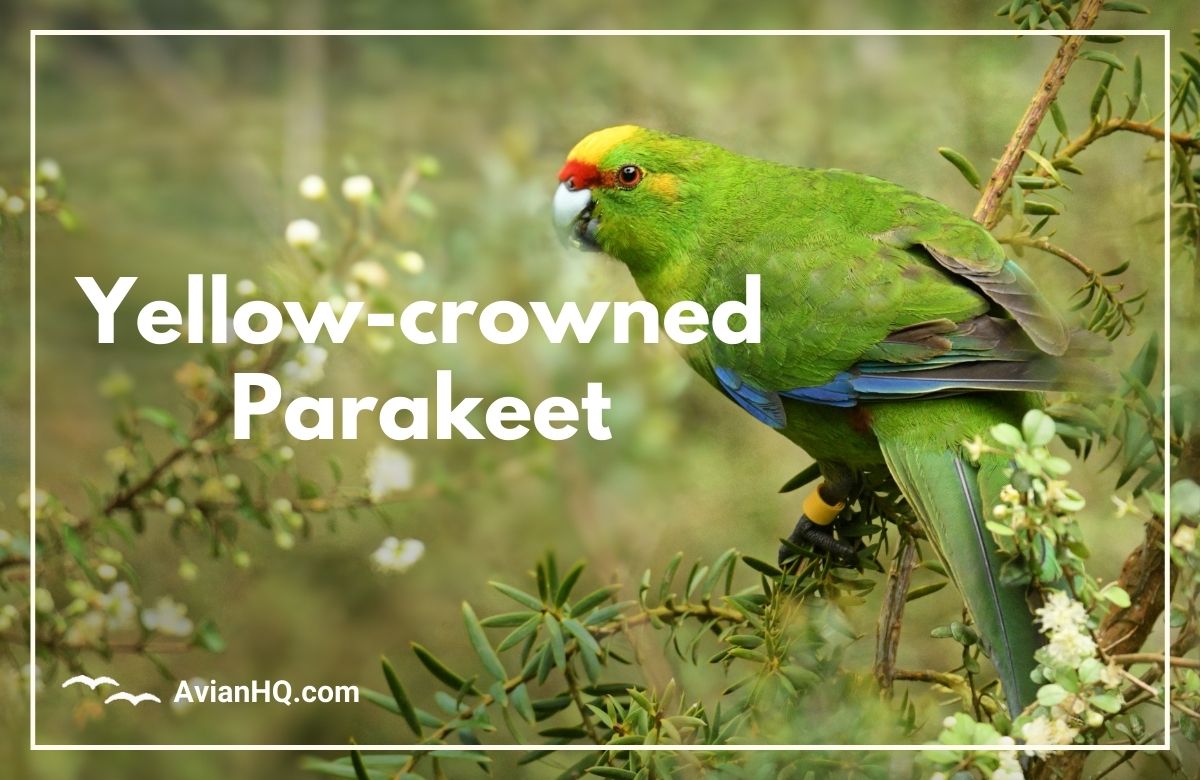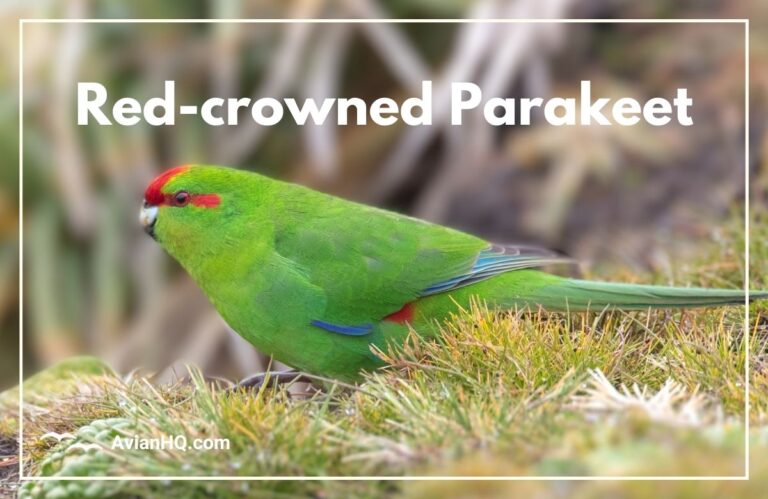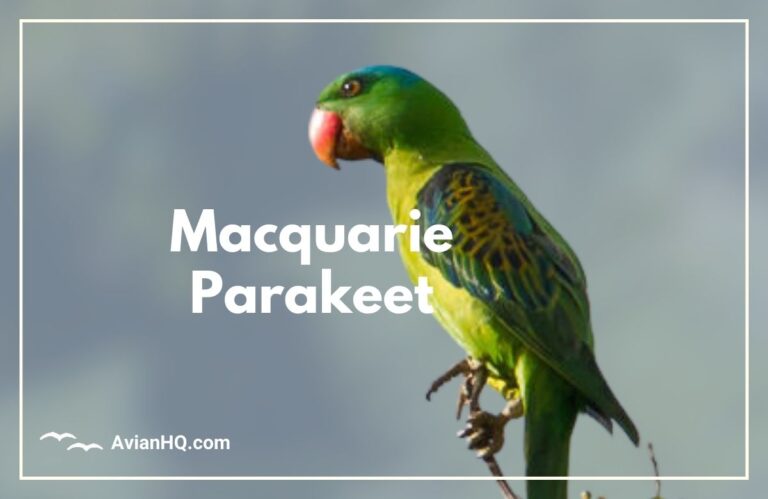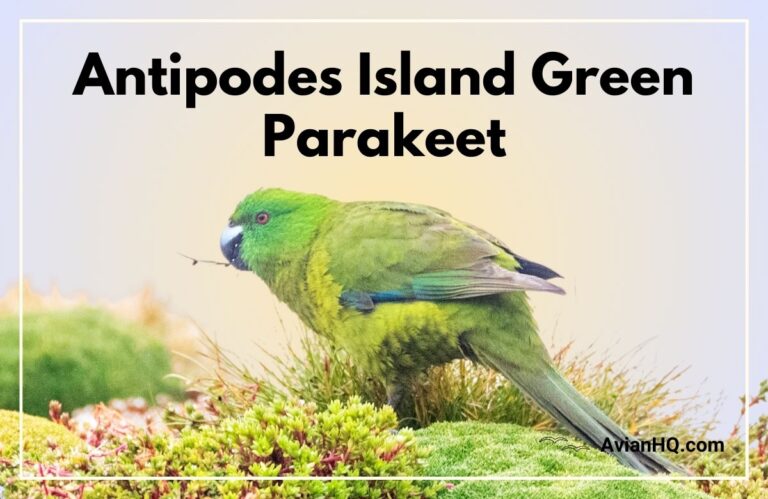Yellow-crowned Parakeet (Cyanoramphus auriceps)
Have you ever seen a small, bright green parrot with a forward-curving yellow crown? If you were in New Zealand, you may have spotted the Yellow-crowned Parakeet (Cyanoramphus auriceps), a beautiful and unique bird found only in that island nation. Though small in stature, reaching around 11 inches (28 cm) in length, these parakeets make up for it with their vibrant green and yellow plumage and loud, chatter-filled calls.
Yellow-crowned Parakeets, also known by their Maori name of kākāriki, are members of the parrot superfamily Psittacoidea, which includes all parrots and parakeets. But what sets these birds apart is the golden-yellow crown of feathers that gives the species its common name. This vibrant curved crown is unique among parakeet species and makes them easy to identify.
These small parrots are endemic to New Zealand, meaning they occur naturally nowhere else in the world. Within New Zealand, Yellow-crowned Parakeets mainly occupy offshore and outlying islands, though they once had a wider range across mainland areas too. Today, the survival and future of these birds depends greatly on conservation efforts, as they face threats from habitat loss, non-native predators, and climate change. But the good news is that their populations can recover when predators are controlled and nesting sites protected.
In this article, you’ll learn all about the natural history of the Yellow-crowned Parakeet—from its taxonomy and physical appearance, to its habitat, feeding, breeding behaviors, conservation status, and cultural significance for New Zealanders. So read on to uncover the secrets of this eye-catching and uniquely Kiwi parrot.
History and Taxonomy
The first known scientific description of the Yellow-crowned Parakeet was made by the famed English ornithologist John Gould in 1845. Based on specimens collected from New Zealand’s South Island, Gould named the species Platycercus auriceps in Latin, meaning “little broad-tailed gold-head.”
For many decades, taxonomists debated whether the Yellow-crowned Parakeet warranted classification as a full species or was better considered a sub-species of the similar Red-crowned Parakeet. At a mere 8 to 9 inches (20 to 23 cm) long, both these small green parrots with golden crowns share visual similarities. Ultimately, more thorough scientific analysis was needed to resolve their taxonomy.
In the 1990s, molecular studies and genetic sequencing confirmed that the Yellow-crowned and Red-crowned Parakeets were definitively separate species. As a result, today the Yellow-crowned Parakeet‘s accepted scientific name is Cyanoramphus auriceps. The genus Cyanoramphus includes eight other closely related parakeet species, all residing exclusively in New Zealand or on surrounding islands.
So while Gould first introduced these birds to science in 1845, it took over a century to fully establish the Yellow-crowned Parakeet as a distinct species from genetic testing. Yet, its uniqueness had long been hinted by the bright golden-yellow feathers curving forward prominently on its crown—a trait seen in no other parakeets globally. This eye-catching crown gives the species its common English name and serves as its most identifiable signature.
Physical Appearance
The most striking feature of the Yellow-crowned Parakeet is of course the golden-yellow crown of feathers that sweeps forward prominently above its beak. This vibrant curved crown gives the species its common name and is key to identifying it.
Beyond the regal yellow crown, these small parakeets display a primarily bright green plumage across the head, back, wings, and tail. Their green feathers have a yellowish tinge of varying intensity. The rump is more blue-green in color. The face and throat area are a duller olive-green.
Male and female Yellow-crowned Parakeets do exhibit some slight physical differences in coloration. Males tend to have a more extensive and brighter yellow crown, while females show a smaller and slightly duller golden crown. Females also display more blue and olive tones mixed throughout their predominately green plumage.
Like other parrots, Yellow-crowned Parakeets show a cere above the curved beak which is grayish-white to pale blue in color. The beak itself is a horn color, while the eyes are brown with pale yellow eye-rings. Legs and feet are gray.
Juveniles hatch with a pale green down and develop adult plumage around three months old. But young fledglings initially show underdeveloped golden crown feathers, which only reach full vibrant yellow a year later during their first molt.
From beak to tail tip, these parakeets measure around 11 inches (28 cm) in total length. Their wingspan ranges about 13 inches (33 cm) across. They are diminutive in size compared to some parrot species, but make up for it with their brightly-colored plumage and loud vocalizations.
Habitat and Distribution
The Yellow-crowned Parakeet is an endemic species found only in New Zealand. These birds once occupied a wider range across New Zealand’s North and South Islands before human settlement. But habitat loss and the introduction of invasive predators decimated populations, restricting them largely to offshore and outlying islands.
Today, strongholds for Yellow-crowned Parakeets include Little Barrier Island, Kapiti Island, Codfish Island, and the Auckland Islands. On these islands, the birds inhabit a variety of habitats including coastal broadleaf and southern beech forests, scrublands, grasslands, wetlands, and sand dunes.
In forested areas, Yellow-crowned Parakeets make use of tree cavities for nesting. But they also reside on small rocky islets that lack trees, nesting among rock crevices and cliffs. The species adapts readily across this island terrain to find suitable breeding sites and sufficient food sources.
Recently, conservation efforts have successfully reintroduced populations of Yellow-crowned Parakeets to a few fenced sanctuary sites on New Zealand’s mainland. These include Zealandia Wildlife Sanctuary in Wellington and the Orokonui Ecosanctuary near Dunedin. Within the safety of predator-proof fencing, the birds thrived once again in their native forests alongside other endangered species.
So while offshore islands serve as the modern strongholds for the Yellow-crowned Parakeet, active repopulation efforts back on the mainland offer hope for future expansion of its fragile habitat range across New Zealand.
Diet and Feeding
The Yellow-crowned Parakeet is an omnivorous bird that incorporates a diverse diet of both plant and animal matter. However, the majority of its feeding centers on various seeds, fruits, nectar, and blossoms. This gives them a predominantly herbivorous diet.
These nimble parakeets employ their curved beak and tongue to extract and ingest seeds from seed pods, cones, and the fruiting bodies of herbs and shrubs. Favored plant foods include the seeds of native trees like rimu, totara, and beech. They also forage for seasonal fruits and nectar from flax, kowhai, fuchsia, and rata flowers.
While vegetation makes up the bulk of their intake, Yellow-crowned Parakeets supplement their diet with some animal protein too. They may feed opportunistically on insects and larvae, or raid nests for eggs and hatchlings. This can include feeding on the chicks of other bird species. The addition of occasional insect and egg prey provides these parrots added nutrition for breeding.
Yellow-crowned Parakeets employ a variety of foraging techniques to locate and access food each day. These include picking apart flowers and cones, crawling along branches, fluttering and hovering near foliage, or hanging upside down to reach. The birds may feed solitarily or in small flocks, calling out with sharp chattering “kek-kek” sounds.
Throughout the day, you can observe these bright green parakeets actively foraging among the canopy and lower scrub. Their broad diet and flexible feeding behaviors likely assist the species in utilizing a diversity of island habitats successfully across New Zealand offshore regions.
Breeding and Reproduction
The Yellow-crowned Parakeet breeds in the spring and summer months from October to January. They form monogamous breeding pairs during this period, frequently returning to the same partner year after year.
Courtship displays involve the male parakeet feeding the female and offering her potential nest hollows for inspection. Once a suitable nest site is chosen, the pair works together to prepare the hollow, lining it with wood dust and small wood chips. Common nest locations include tree cavities, rock crevices, or burrows dug into earthen cliffs.
The typical clutch size is around 5-7 white eggs that the female lays over intervals of several days. She then incubates the eggs alone for about 21 days before they begin hatching as helpless chicks. Meanwhile, the male provides food for his brooding partner throughout incubation.
After all the chicks hatch, both parents share duties feeding the young parakeets. They offer regurgitated food from their crops to satisfy the hungry fledglings. Young leave the nest at 6-7 weeks old, but continue relying on their parents for additional care and feeding as juveniles.
Yellow-crowned Parakeets reach sexual maturity by about 18 months old. Maximum lifespan in the wild is up to 15 years. Pairs often breed yearly to keep pace with mortality rates from exposure and predators across their restricted island habitats. Successfully raising numerous clutches over this decade and a half lifespan is key to ensuring this species’ continued survival amid ongoing risks.
Behavior and Ecology
The Yellow-crowned Parakeet is a highly active and noisy bird, spending its days busily climbing through trees and vegetation while keeping up steady streams of loud calls. Their bright green plumage and incessant chatter makes them a conspicuous presence as they gather and travel about in small flocks.
These highly sociable parakeets communicate with one another frequently through a repertoire of various squawks, screeches, kek-kek-kek alarm calls, and other sounds. Their cries tend to fluctuate sharply in pitch and intensity as they pass along different messages. You’ll rarely observe a silent group for long!
Beyond calling out vocally, Yellow-crowned Parakeets also rely on visual cues for signaling. Watch for various posturing like head bobbing or wing fluttering to express threats, courtship advances, greetings or fledgling begging calls for food. Even the colours of their iridescent crown feathers may shift in tone based on mood.
Grooming represents another important social behavior for parakeets to strengthen bonds and maintain healthy plumage. You may witness pairs or groups carefully preening one another around the head and neck areas they can’t easily reach themselves. Their blissfully closed eyes and relaxed posture indicates shared pleasure.
Dust bathing also helps keep their feathers clean. By wriggling in dry dust or dirt, the particles penetrate through the plumage, absorbing excess oils and skin irritants. Afterwards, grooming kicks off the dust to tidy the coat again. You might catch sight of these amusing contortions low in vegetation or on the ground.
In the wild, Yellow-crowned Parakeets can live approximately 10 to 15 years. Maintaining high flock numbers across suitable breeding habitats provides these gregarious birds enough genetic diversity and protection to survive despite ongoing predation risks from invasive pests. Through continued management of their fragmented island niches, we can assure future generations of this uniquely-crowned New Zealand endemic.
Conservation Status
Due to severe population declines and increasing pressure on their limited habitat range, the Yellow-crowned Parakeet is currently classified as Vulnerable on the IUCN Red List of Threatened Species. Ongoing conservation management is needed to protect this endemic New Zealand bird.
Major threats contributing to their worried status include deforestation, non-native predators, illegal trapping, competition for nest sites, and potential future impacts from climate change. With populations already restricted to offshore islands and a few mainland sanctuaries, these multiple risks remain concerning.
Deforestation and habitat loss from early European settlement vastly reduced the habitat range for Yellow-crowned Parakeets in New Zealand. Meanwhile, introduced predators like rats, stoats, cats and possums preyed extensively upon adults and eggs alike, decimating their numbers. The species became effectively exiled to predator-free outlying islands.
Though island conditions supported less competition and threats for the parakeets, these tiny remnant populations also grew severely inbred. Moreover, storms can easily overwhelm tiny islets, eliminating an entire local genetic lineage in one blow. So their long-term survival pivots on active ecosystem management.
To aid the species, conservation groups now administer proper pest control programs, regularly monitor populations, provide nest boxes, and breed birds in captivity for release. These efforts help expand populations back into mainland reserves inside predator-proof fencing for greater genetic diversity. Maintaining this support long-term offers the best hope of one day down listing the Yellow-crowned Parakeet to a safer conservation status.
Cultural Significance
The vibrant green plumage and distinctive yellow crown of the Yellow-crowned Parakeet make this endemic bird a recognized cultural icon for New Zealand. Known by their Māori name of kākāriki, these small parakeets feature prominently across New Zealand artwork, literature, postage stamps, and national symbolism. They even appear occasionally as pets.
In traditional Māori folklore, the kākāriki brought important knowledge to humans from the native forest gods. Their high-pitched chattering was thought to form part of the forest’s living spirit. So killing these cherished birds was tapu (forbidden). These beliefs likely helped uphold early protections for the vulnerable species during ancient times.
Today the Yellow-crowned Parakeet remains an oft-used symbol celebrating New Zealand’s unique wildlife. It has graced multiple commemorative postage stamps issued by New Zealand Post over past decades. Kākāriki artwork motifs also adorn popular souvenir products for the tourism sector. And whenever global entities promote Brand New Zealand abroad, you’ll surely spot this iconic parrot somewhere in the colorful imagery!
Beyond their strong national symbolism, a limited number of bird enthusiasts also keep Yellow-crowned Parakeets as pets. Strict regulations govern captive breeding of this vulnerable species however to prevent endangering wild populations through illegal poaching of eggs or chicks. Any private aviculture efforts must ensure genetic diversity and pair numbers that support eventual release back to the islands one day if needed.
So while human activities have severely threatened these parakeets in the past through deforestation and invasive species, today New Zealanders proudly uphold the Yellow-crowned Parakeet as an endemic treasure through ongoing cultural celebration and environmental protection efforts nationwide.
Conclusion
The vibrant Yellow-crowned Parakeet stands out as one of New Zealand’s most recognizable endemic bird species. Its bright golden crown feathers curving forward boldly above an overall green plumage make this small parrot truly distinctive in the avian world.
Yet what makes this species so exceptionally special is that it occurs nowhere else globally but New Zealand and its surrounding islets. After evolving for over two million years in ancestral isolation, the archipelago’s remote geography allowed a diversity of unique birds like the kākāriki to flourish through deep time relatively free of predators.
Tragically, the past few centuries of human environmental destruction severely imperiled this innate island biodiversity. Deforestation and invasive mammals encroached heavily on native species, with endangered endemics like the Yellow-crowned Parakeet losing over 90% of their former range wide population.
Only through intensive conservation management in recent decades to protect and restore offshore island habitats has the species begun recovering from this former brush with extinction. Continued predator control, population monitoring, public education, and possible reintroductions back to mainland reserves now offer genuine long-term hope for a brighter future.
So when glimpsing this eye-catching yellow crown bobbing through native forest canopies, we must recall both the deep roots and fragile foothold of this endemic legacy. All New Zealanders share collective responsibility to restore the habitats that sustain the exceptional biodiversity of rare species like the Yellow-crowned Parakeet across their ancestral home.







